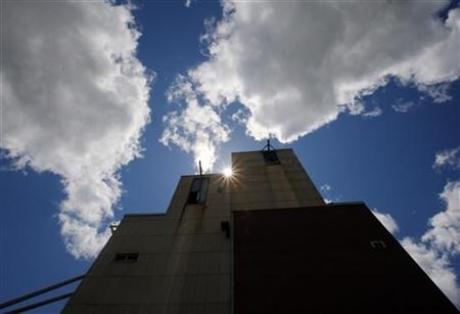How Will Upcoming U.S. Rules Affect Biofuels?
Country: US
Author: Timothy Gardner

The sun glints from behind the digesters at the Old Town Fuel and
Fiber mill in Old Town, Maine, June 2, 2009.
Photo: Brian Snyder
WASHINGTON - U.S. environmental regulators are expected to issue new rules that could fine tune targets for alternative motor fuels like grain-based ethanol and advanced biofuels to be blended into the country's petroleum mix.
The rules, known as the second Renewable Fuels Standard, or RFS2, may affect both ethanol made from corn and advanced fuels like cellulosic ethanol, which companies have begun to make from the tough bits of corn waste and non-food crops like switch grass and poplar trees.
The industry is wary of any new rules as stronger operating margins have begun to help companies like oil refiner and ethanol player Valero Energy Corp.
WHEN?
The Environmental Protection Agency has repeatedly delayed finalizing RFS2 rules, which build on a program first created in 2006. The EPA submitted the RFS2 rules to the Office of Management and Budget in late December, 2009 and is expected to announce the rules any day.
WHAT IS INDIRECT LAND USE CHANGE?
The most controversial item the EPA is considering under RFS2 is how to measure greenhouse gas emissions due to land use changes from the expansion of food or biofuels croplands abroad caused by growing U.S. biofuels, known as indirect land use change. The ethanol industry fears ILUC could put some limits on production of transportation fuels made from grains.
ILUC could penalize some biofuels, like traditional ethanol made from corn, by factoring in the carbon emissions from cutting down forests to make room to grow food or energy crops in countries like Brazil. ILUC backers say increased land used for ethanol in the United States causes such deforestation.
The industry says moves on ILUC are unfair because corn ethanol makers are producing more of the fuel with less land amid new uses of hybrid seeds, fertilizer and irrigation.
Last April, California adopted the first ever rule to attempting to cut carbon emissions in motor fuels that ethanol makers said included a bias against biofuels.
WHAT INDUSTRIES WILL RFS2 AFFECT?
The rules could reduce the amount of cellulosic ethanol required to be blended into gasoline this year. Previously 100 million gallons (378.5 million litres) of cellulosic ethanol, which is not easy to make, were required to be blended into gasoline in 2010.
But the recession and tight credit markets have slowed the industry and a more realistic production schedule may result from RFS2.
New ethanol plants that make the alternative motor fuel from corn could face restrictions under ILUC. But U.S. annual production of corn ethanol is already about 13 billion gallons per year and national mandates call for a maximum of 15 billion gpy by 2015, so the impact on new corn ethanol plants could be limited. Old corn ethanol plants are not subject to the new rules.
The EPA had originally been expected to rule by December 1 2009 on whether to raise the allowed level of ethanol in fuels to be burned in all cars from 10 percent to 15 percent (E15). The EPA, which has indicated E15 is safe for newer cars, has delayed the ruling until May 2010 to conduct further tests on how the blends affect engines of older cars.
In January a coalition of automakers and oil companies submitted a letter to the EPA asking them to further delay a decision to conduct more tests. Some analysts say the EPA could approve E15 for newer cars later this year, but it could be costly for oil refiners to adjust to the different markets.
(Editing by Marguerita Choy)
© Thomson Reuters 2010 All rights reserved
